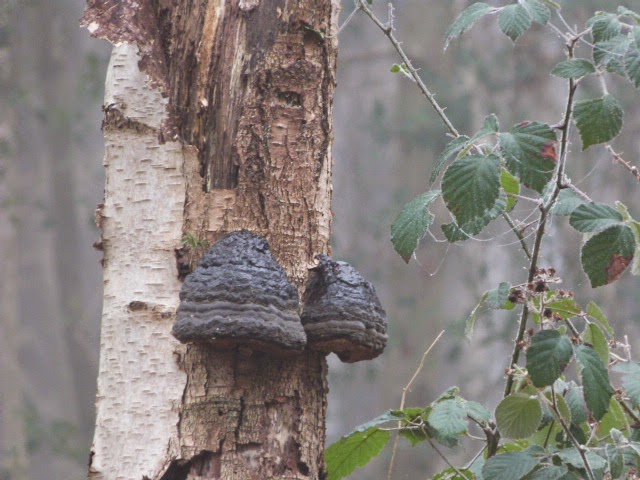 |
| You can't beat sunlight through the trees in summer - Peak District |
 |
| The forest in winter - Whinlatter, Cumbria |
The workshop was run by Tony Saunders, the honorary reserve manager at Brown Robin and a man who knows a lot about trees! Tony runs his own coppicing courses and workshops and had a lot of tips and info on trees. We mainly looked at twigs, bark and buds and Tony explained the differences between these on various trees and pointed out clues to help with identification. The first tree we looked at was a sycamore. It had a smooth bark which was greyish in colour. Being an old tree the buds were way up high and so I haven't got a pic of them!
 |
| Sycamore - Brown Robin Reserve |
 |
| Witch Elm - Brown Robin Reserve |
 |
| Hazel with its many shoots and branches - Brown Robin Reserve |
 |
| Hazel catkins - Brown Robin Reserve |
 |
| Hazel shoots - Brown Robin Reserve |
 |
| Ash tree bark - Brown Robin Reserve |
 |
| Buds of an ash tree - Brown Robin Reserve |
 |
| Rowan bark - Brown Robin Reserve |
 |
| Rowan Tree - Brown Robin Reserve |
 |
| Silver Birch - Brown Robin Reserve |
 |
| Horse hoof fungus on dead standing wood - Brown Robin Reserve |
 |
| Loads of horse hoof fungus - Brown Robin Reserve |
 |
| Coppiced area - Brown Robin Reserve |
 |
| Piles of coppiced wood - Brown Robin Reserve |
 |
| Oak tree - Brown Robin Reserve |
 |
| Oak apple and buds - Brown Robin Reserve |
 |
| Hornbeam tree- Brown Robin Reserve |
 |
| Hornbeam bark - Brown Robin Reserve |
 |
| Hornbeam - Brown Robin Reserve |
 |
| Spindle Tree - Brown Robin Reserve |
 |
| Spindle Tree - Brown Robin Reserve |
 |
| Beech Tree - Brown Robin Reserve |
 |
| Beech Tree Bud - Brown Robin Reserve |
 |
| Big old Beech tree - Brown Robin Reserve |
 |
| Beech Masts - Brown Robin Reserve |
 |
| Big old gnarly tree - Brown Robin Reserve |
 |
| North facing orange lichen - Brown Robin Reserve |
 |
| North facing orange lichen on ash tree - Brown Robin Reserve |
 |
| Cherry bark - Brown Robin Reserve |
 |
| Cherry and Hornbeam trees - Brown Robin Reserve |
 |
| Woodworking area |
 |
| The new tarp erected yesterday - great for a brew area |
 |
| The ghillie kettle bubbling away |
 |
| The charcoal kiln |
 |
| This one is self explanatory! |
.....and so in the afternoon I took my dog out for a walk and practised some of my new skills. I was mainly however surrounded by oaks but I had fun looking more closely at the bark, hunting for acorns and inspecting some oak apples. Trees truly are fascinating.
 |
| Acorn cups under an old oak at Low Fell |
 |
| Oak apple on an old oak tree at Low Fell |
 |
| Big gnarly bark of a big old oak tree at Low Fell |
 |
| Interesting trunk of a holly tree - Low Fell |
What an amazing and inspiring day and I would like to mention two other things that have I have been thinking about whilst wandering in the woods and that is things I have read in books recently. I would highly recommend both of these books as a great read. The first is a piece I read in "My Outdoor Life" by Ray Mears, where good old Mr Mears states that when you want to learn about something you should start slowly and simply and then add layers to it.
This is something I totally agree with. I love learning and can immerse myself in a subject but it so true with anything in nature that you have to start slowly and build up. I did this with wildflowers - I started with the common wildflowers and learnt to identify them and then I now go out and look for more unusual ones. The same method will be applied to winter trees!
The other is in a book "The Nature Book" by Marianne Taylor, where she writes that there is so much to learn about nature that you can never know it all, but the more you delve into it the more you want to know. And I will leave you with that thought......
References/Books:
Taylor M., (2009) Michael O'Mara Books Ltd "The Nature Book"
Mears, R., (2013) Hodder & Stoughton Ltd "My Outdoor Life"
https://www.woodlandtrust.org.uk/learn/british-trees/native-trees/spindle/ (Accessed 9 February 2015)
Also have a look at Tony's website for green wood courses - the link is highlighted above to go straight to his page:
http://ynotcoppice.weebly.com/
or visit him on Facebook:
https://www.facebook.com/YnotCoppice
Really informative post on trees and great photos, as always. Am very much enjoying following your blog :)
ReplyDeleteThanks Lisa - I'm glad you're enjoying it!
ReplyDelete